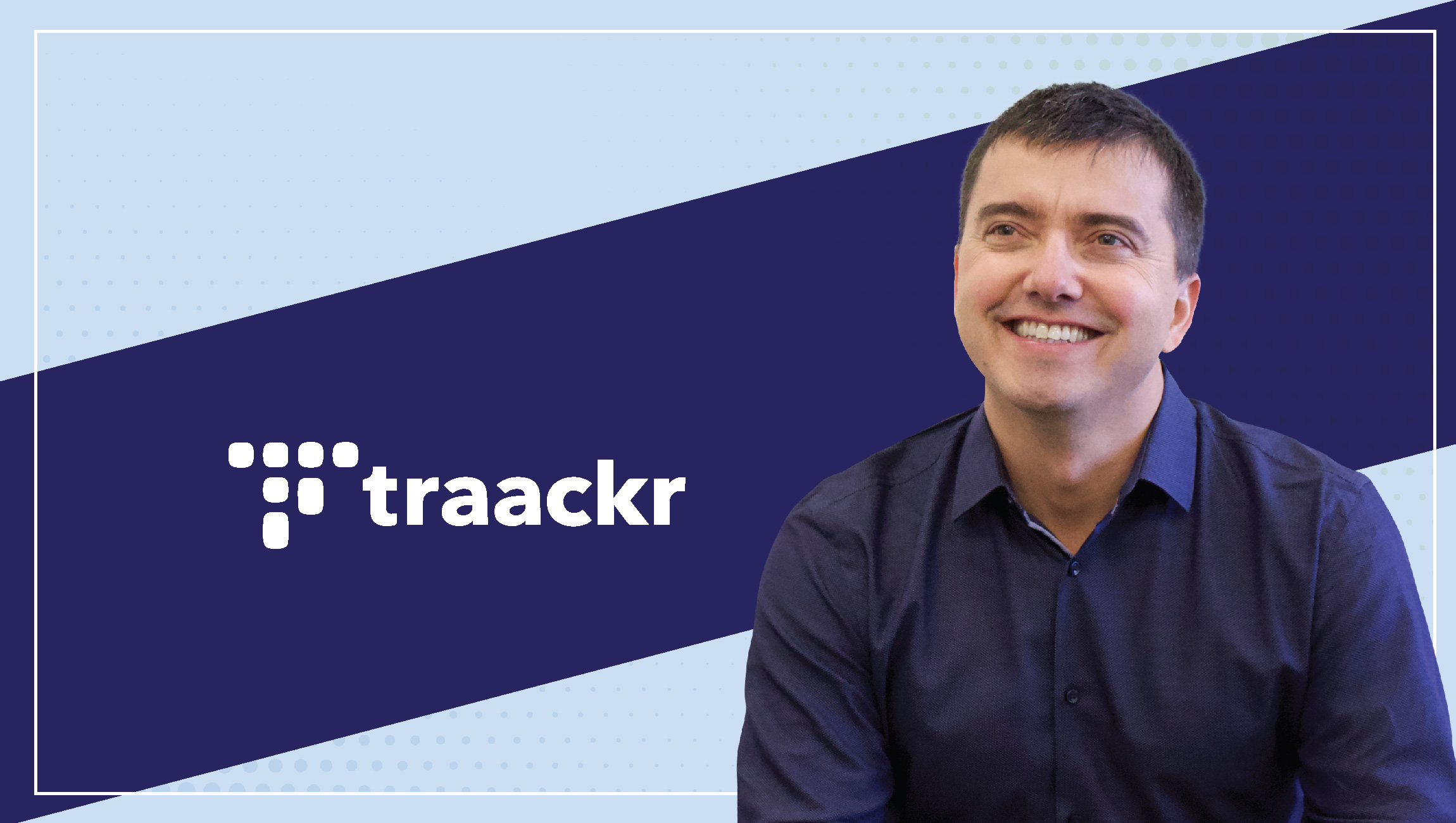Tell us about your role and journey into Technology. What inspired you to start Traackr?
It’s been a journey indeed! I started my career in Marketing for Procter & Gamble and Peugeot in Europe, before immigrating to the United States from France, by way of the UK and Spain, and transitioning to an internet technology entrepreneur 20 years ago.
I refer to myself as a “recovering marketer” because when I started out in Marketing it was during the time of traditional marketing, referred to as the “art of persuasion,” which never made sense to me. It always felt that one-way Marketing success was due to a lack of alternatives.
What excites me today is that for Marketing to succeed, a brand has to genuinely be better than the alternatives and marketers have to be smarter than the competition. I Co-Founded Traackr because I wanted to help marketers drive the change needed within their organizations so that their brands stay relevant to today’s consumers.
What is Traackr and how does it fit into a modern Marketing Technology stack?
Traackr is an end-to-end Influencer Marketing platform powering influencer discovery, evaluation, relationship management, campaign planning, and reporting. With the introduction of the Influencer Market Benchmark (IMB), we’ve now added market-level benchmarking and competitive insights. For our customers, Traackr is the single system-of-record for Influencer Marketing.
Which businesses are fastest to the adoption of Influencer Marketing platforms? How does it impact Branding and Marketing operations?
We work with large and small organizations across diverse industries including beauty, fashion, pharma, consumer technology, hospitality, and B2B technology. Within these sectors, I see two groups of businesses quickly adopting Influencer Marketing platforms. One group consists of large enterprises who’ve realized that their old approach to Marketing is no longer effective in reaching their audience. At the core, these types of organizations understand that to be successful today, they must lead with brand purpose and collaborating with influencers is often a catalyst for these brands. The second group were brands born on purpose. Sometimes referred to as digitally-native, these brands often worked with influencers from the get-go.
Apart from Social media branding, how can Companies better leverage Influencer Marketing platforms?
A company typically looks to bring on an Influencer Marketing technology as part of their path to scale. They are looking for technology that will surface actionable insights, increase efficiencies, enable collaboration and support constant reporting.
Tell us more about your recent solution- IMB. How can Marketing teams benefit from their capabilities?
IMB provides the standard for measuring the impact of influencer content on brand performance. For the first time, Marketing teams can now measure influencer strategies accurately, constantly and most importantly, transparently. Until the launch of IMB, the lack of reliable measurement for Influencer Marketing has been a major hurdle for large organizations.
Now Marketing teams can assess Influencer Marketing from a new vantage point. You can see your performance, not just among the influencers you know, but among the entire influencer market. You can compare your brand to your competition, to the market, and over time. Most crucially, you can make decisions based on hard data.
Along with IMB, we also introduced a new metric, the Brand Vitality Score (VIT), which alleviates our industry’s reliance on legacy indicators like AVE or EMV, which have long been denounced by global professional organizations for their flawed methodology. Metrics drive behavior, which is why creating purpose-driven benchmarks with accurate data and insights to measure influencers’ impact was essential.
VIT measures the visibility, impact and trust influencer content mentioning your brand earns. What makes VIT so exciting is that it’s purpose-built for measuring Influencer Marketing, it provides a simple way to benchmark an industry, but it also enables transparency.
What is the relation between Influence and Brand Loyalty?
There are two ways to interpret this question; both interesting.
There is a strong correlation between the impact an influencer can have on their community when endorsing a brand if they have already demonstrated an affinity towards the category and the brand itself. The authenticity of influencer content is tightly connected to its success – this does not mean at all that brands should only work with influencers who already like them, but that before discussing any kind of collaboration, the brand ought to convince the influencer they are worthy.
Now if the question is about influencer marketing vs. loyalty programs, the connection is strong but more distant. A brand with a strong brand purpose will likely focus on both an influencer strategy to assert the authenticity of its purpose among its buyers as well as a loyalty program. Customers who buy based on brand values vs. product features demonstrate much higher loyalty towards the brand. In this sense, an influencer program contributes significantly to these brands toward increasing its brand loyalty with consumers.
Which brands have managed to successfully transform their brand influencer campaigns using events?
Events give brands a chance to get to know influencers on a deeper level – connecting with their key audiences and conveying their brand story; this also allows influencers ample opportunities to experience the brands in new and exciting ways. Many of our customers have collaborated with influencers for key events including L’Oreal, Michelin, Samsung, amika, Melia Hotels International, SAP and more.
For example, amika has invited influencers on trips that give the brand teams and influencers more chances to get to know each other and create content together which can be used across channels outside of the event. On the B2B side, SAP often invites influencers to their key industry events. In addition to providing an opportunity to deepen relationships, events like SAPPHIRE NOW give influencers the ability to create content for their own audiences.
Tell us about your technology integrations with other Marketing Technology platforms such as Contacts, Social Media, Automation, Contracts, Email, and Customer Service.
With a few exceptions, we do not have standardized integrations with other Marketing platforms. As best practices are still being defined and optimized by our customers, going too fast towards imposing a specific workflow is not desirable in our opinion. However, our platform is technically equipped (through our REST API) to support various bespoke integrations for our customers as they define these same workflows for their organization.
Which Marketing and Sales Automation tools and technologies do you currently use?
Our revenue stack consists of Salesforce, Pardot, Drift, LeanData, Rollworks, LinkedIn Marketing Solutions, Hootsuite, and, of course, Traackr.
What are your predictions on the most impactful disruptions in Influencer Marketing technology for 2019-2020?
We anticipate that access to more insights and benchmarking data will contribute to the normalization and optimization of Influencer Marketing workflows as well as a significant increase in investment in the practice (now that management can invest wisely.) Also, if the last 10 years have taught us anything, it’s that new platforms are always on the rise. I expect to see new social networks emerge and attract influencers to their ranks.
What startups in the technology industry are you watching keenly right now?
I’m closely following the brand technology space, which has a whole is developing new solutions to help brands embrace people-focused Marketing. Some of these companies include 55 the data company, Vidmob, and EVRYTHNG.
How do you prepare for an AI-centric world as a Business Leader?
There’s only one way to prepare, in my opinion, and it is to preserve as much data as one can. Algorithms and the applications they unveil will only continue to evolve faster but they will always only be as good as the data they can ingest. So if you don’t want to fall behind, keep your data!
How do you inspire your people to work with technology?
I encourage my team to work smarter, not harder. Technology should enable, streamline, facilitate processes and most importantly help us make better decisions.
One word that best describes how you work.
Focused.
What apps/software/tools can’t you live without?
Trello. It’s a tool I discovered from our Product team. Today, we use it across the organization and I personally organize my priorities with it. It’s the one “to-do management” system that I’ve stuck with over the years.
What’s your smartest work-related shortcut or productivity hack?
Walking meetings have become my new norm. I find it’s a great way to explore ideas with my team.
What are you currently reading?
I’m currently re-reading Zone to Win: Organizing to Compete in an Age of Disruption by Geoffrey Moore. I normally read physical books, but recently discovered Blinkist, which is great for screening new books.
What’s the best advice you’ve ever received?
Not to listen to everyone’s advice.
Something you do better than others – the secret of your success?
I simplify complex problems.
Tag the one person in the industry whose answers to these questions you would love to read:
Satya Nadella.
Thank you, Pierre-Loic! That was fun and hope to see you back on MarTech Series soon.
Pierre-Loic Assayag is the CEO and Co-Founder of Traackr, a platform that builds influencer relationship management technology enabling brands to effectively manage, measure and scale influencer strategies while cutting through the noise on social media.
He is passionate about turning powerful ideas into reality using technology. As Marketing is being re-invented, Pierre-Loic co-founded Traackr as a way to ease the transition for the modern marketer.
 We transform brands with Influencer Relationship Management and are the standard for measuring the impact of influencer content on your market share.
We transform brands with Influencer Relationship Management and are the standard for measuring the impact of influencer content on your market share.
With one tweet, tap, or snap we interact with our peers in an instant, as we do with brands. This new social fabric affects how people relate to and involve themselves with brands, ultimately enabling them to be more than just buyers. At Traackr, we see our technology and our team as agents of change to support our customers through their transformation. Our clients include L’Oréal, Coca-Cola, Google, Microsoft, Samsung, and Nissan.
We have fostered a culture that empowers our team to spend every ounce of energy towards solving our customers’ problems and lifting their businesses through Influencer Marketing. It’s our method that tames the madness.
The MTS Martech Interview Series is a fun Q&A style chat which we really enjoy doing with martech leaders. With inspiration from Lifehacker’s How I work interviews, the MarTech Series Interviews follows a two part format On Marketing Technology, and This Is How I Work. The format was chosen because when we decided to start an interview series with the biggest and brightest minds in martech – we wanted to get insight into two areas … one – their ideas on marketing tech and two – insights into the philosophy and methods that make these leaders tick.











